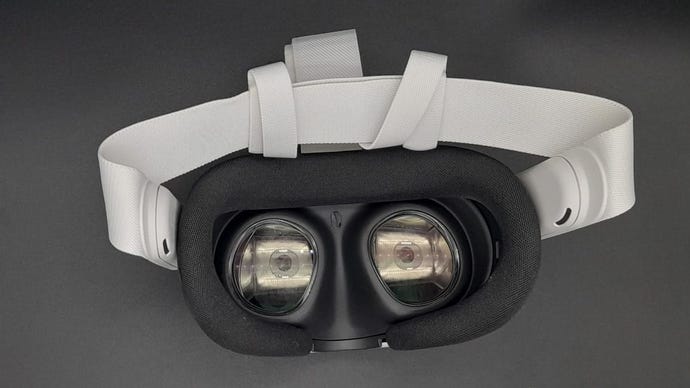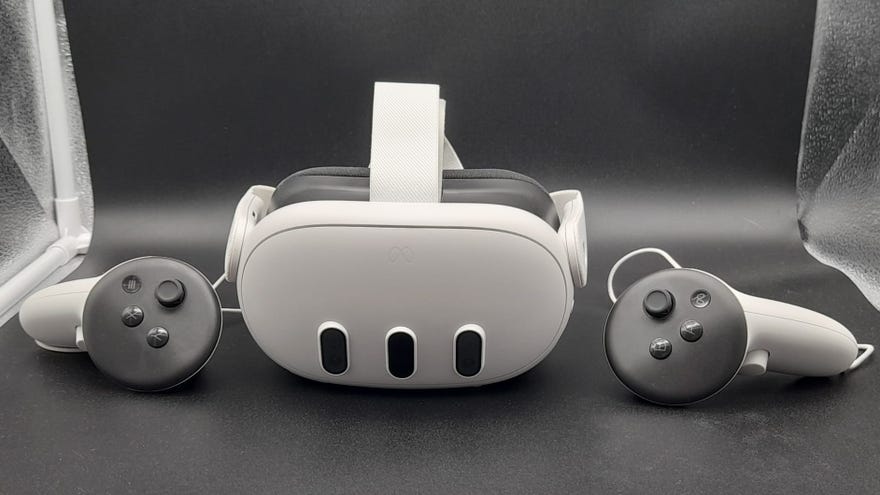Meta Quest 3 review: Meta’s best VR headset yet, but the jury’s out on mixed reality
Mixed opinions
Meta may have spent the last couple of years tumbling down a metaverse rabbit hole, but the company is still responsible for creating the best VR hardware around. The Meta Quest 2 was the ideal gaming VR package: powerful and accessible enough to provide easy, convincing immersion, while also staying highly affordable. Nonetheless, Meta’s sudden fixation on creating a legless version of Second Life did have me worried about the future trajectory of its VR hardware. What daft gimmickry would their next headset come festooned with, and what would it mean for the future of the Quest as a gaming device?
With the Meta Quest 3, we have the answer. And the truth is, Meta’s latest headset does have a whiff of Metaverse about it. Dubbed a "mixed reality" device, its raison d’être is to break down the barrier between reality and the virtual world. While mixed reality is an angle I’m not wholly sold on from a gaming perspective, crucially, the features that make it a mixed reality device are useful even if you don’t want to hold a meeting in your office with a bunch of bisected Sims. Moreover, they’re built into a headset that is more powerful, more comfortable, and generally better than the Meta Quest 2.
The most visually obvious change to the Quest 3’s design is the twin, front-facing RGB cameras situated on the headset’s faceplate. These facilitate my favourite new feature of the Quest 3 – coloured passthrough. Previous iterations of the Quest enabled you to see your surroundings through the headset via cameras, but the image was low res, black & white, and overall not especially useful.
The new passthrough is not only considerably sharper, it’s also full colour, and this makes a profound difference to setting up your headset and multitasking while wearing it. Not having to take the headset off every time you want to move something, have a drink, or speak to someone is quietly transformative. If you’re playing a game, you can switch back to passthrough mode by double-tapping the arms of the headset. This works fairly consistently with the Touch Plus controllers, but is slightly less reliable when using hand tracking.
While hugely improved, the passthrough image is still far from crystal clear. I was able to read my WiFi password on the underside of my router, for example, but doing so took a fair amount of squinting. You’d also struggle to read something on another screen unless it’s in a very large font. Nonetheless, the new passthrough makes the entire VR experience both less fussy and less disorienting.
Alongside coloured passthrough, The Quest 3 introduces a couple of other features that make the general VR experience smoother and more pleasant. The first is Direct Touch, which is a kind of simulated haptic feedback for hand-tracking. When navigating the Quest’s 3 VR menus, Direct Touch makes your virtual finger "stick" to the button, as if there were a little magnet on it. It also lets you move menu screens around by pinching your thumb and forefinger around the edges of the menu bounding box. It’s surprisingly effective at simulating touch, and I enjoyed using it to just navigate through menus like Tom Cruise in Minority Report (if far less rich and handsome). It doesn’t have many applications in VR games yet, as most existing games rely on controllers. But I can see it being significant for a game like Unplugged, where being able to "touch" the guitar frets would make a big difference to immersion.

The last major new feature is also the most likely to be contentious – room scanning. The cameras and depth sensors on the Quest 3’s faceplate make it capable of scanning and digitally memorising your room layout. This has a couple of functions. First, it makes setting up your safety boundaries much easier. Instead of having to physically draw a layout, you can simply look around, and the headset will record the contours of your room and create a boundary that fits within it. It’s fairly accurate too. At the risk of telling the entire Internet how I live, one side of my office is currently piled up with stuff I am putting off taking to the charity shop, and the scan created a boundary that neatly avoided the jumble.
But room-scanning isn’t just a quality of life feature, it’s integral to the Quest 3’s mixed reality aspirations. This is demonstrated in an introductory MR game called First Encounters, which sees you fighting off waves of tribble-like aliens with a pulpy laser pistol inside your room. The key gimmick here is that the aliens smash through the walls and ceiling of your room, revealing a sweeping alien landscape behind.
It's undeniably cool tech, but there are a couple of big caveats. First, its success will depend heavily on the applications made for it. There are a couple on the horizon, like the multiplayer turn-based strategy Demeo Battles, and Lego Bricktales, which lets you play with animated VR Lego sets on your tabletop, but it’s still too early tell how much momentum mixed reality will have. The other big caveat is what data this means handing over to Meta. During setup, the Quest 3 states that it doesn’t capture room data, and asks permission to scan your room when the time comes. But the real issue here is one of trust, and even in the most positive reading, Meta’s record when it comes to data privacy ain’t exactly spotless.
Ultimately, these are all handy new features with substantial, if as-yet untapped potential. But importantly, they come on top of an all-around upgrade of the Quest’s hardware and design. While only a few grams lighter than the Quest 2, the actual box that sits in front of your face is more compact, meaning the sense of it pulling down on your nose is noticeably reduced. It also has an adjusted strap system that combines a soft overhead Velcro strap with sliding side straps for fitting around the circumference of your head. These are quite stiff to adjust initially, and they also snagged my (short!) hair, which is less than ideal. Once fitted, however, the headset is fairly comfortable.

The headset also comes with improved IPD range (IPD being interpupillary distance, or the distance between the centres of your eyes), with a dial on the underside of the headset letting you adjust it between 58-70mm. It supports eye relief adjustment as well, so you can change the distance of the lenses inside the headset from your face. This is a little fiddlier to adjust than the IPD, as the buttons for doing so are on the inside of the headset, but it ultimately makes the Quest 3 more suitable for glasses wearers.
The most dramatic change to the Quest 3’s design, however, is not to the headset but the new Touch Plus controllers, on which the distinctive circular tracking ring has been removed. This signals a change in how the Quest tracks your hands, with infrared sensors in the top and bottom of the controller rather than in the ring. On that note, the tracking cameras in the headset have also changed positions, with two on either side of the headset, as well as the more visible cameras on the front.
Although the Touch Plus look very different, the lack of a tracking ring doesn’t make a vast different to their feel in the hand. Meta’s controllers have always been pretty comfortable, and the Touch Plus are only a few grams lighter and have a similarly ergonomic grip. The main difference is that the absence of the ring leaves room for a proper thumb rest. This is also touch-sensitive, letting the Quest 3 simulate a more nuanced squeezing action.
Importantly, the lack of a tracking ring doesn’t noticeably affect the Quest’s ability to track your movements. Fast reaction games like Beat Saber, Pistol Whip and Vader Immortal’s Jedi Dojo all feel wonderfully slick and responsive. According to Meta, the new position of the sensors and headset cameras notionally makes the Quest 3 less able to read when your arms are above your head. I tested this by playing The Climb 2, one of the few VR games that frequently requires you to reach over your head, and noticed no significant issues with the tracking while doing this.

As for what’s under the headset’s faceplate, it’s upgrades all around. Per-eye resolution, for instance, has increased from 1832x1920 to 2064x2208. But Meta has also switched the Quest 2’s Fresnel lenses for the ‘pancake’ lenses used in the Quest Pro. The result is a noticeably clearer image than that of the Quest 2, which was no slouch in this department to begin with. The clearer display is supported by a second generation, much more powerful Snapdragon XR2 chip, plus 8GB of RAM. You’ll reap the benefit from these upgrades as well: visually ambitious VR games like Red Matter 2 and Hubris have received graphical makeovers for the Quest 3, with added details to bring them in line with their PCVR counterparts.
Speaking of PCVR, it’s worth noting that the Quest 3 can still be used as a PCVR device, via Quest Link and Air Link. I wasn’t able to test the cable link due to a faulty cable, but The Quest 3’s Air Link is dependable enough that I didn’t feel much need to jack in directly anyway.
The Quest 3 comes with two storage options, the familiar 128GB option, and a much meatier 512GB. The latter is the one I tested, and it certainly makes downloading most VR games (which tend to only be a few gigs in size) trivial. Finally, like the Quest 2, the Quest 3 comes with a headphone jack and built-in stereo speakers. Besides an impressive volume range, these speakers enjoy a rich depth of sound; they're not at all tinny or distant, and playing a game like Unplugged, which has actual rock tracks from bands like Weezer and The Offspring, sounded great.

The only real gripe I have with the Quest 3 is the same one I’ve had with every Quest: the battery life. Like the Quest 2, the Quest 3 is supposed to have a battery life of 2-3 hours, but in practice it’s firmly at the lower end of that range. The charging cable is also impractically short, and I don’t just mean that’s it’s too short to play while charging (which it is). If you plugged it into a wall socket directly behind your desk, you’d struggle to charge the Quest on a desktop unless you ran the cable up the back of the desk.
All told, the Quest 3 does represent a significant step forward over the Quest 2. Then again, it really, really should. With an RRP of £480 for the 128GB version, the Quest 3 enters the market at almost £200 more than the Quest 2. Which brings us to the big question: is it worth the price?
I’d break it down like this. If you’re buying a VR headset for the first time, or you’re upgrading from an older headset having skipped the Quest 2, get the Quest 3. It’s still the best Quest headset, and it’s worth coming in at the cutting edge at a price that, if not as affordable as the Quest 2, is at least comparable with modern home consoles. If you already own a Quest 2, though, wait a little and see. The extra power and fidelity are certainly welcome, but they’re only worth investing in if you use VR all the time. The mixed reality features are likewise cool, but right now there isn’t a sufficient library of games that support them to make it worth taking the leap.
This review is based on a retail unit provided by Meta.

